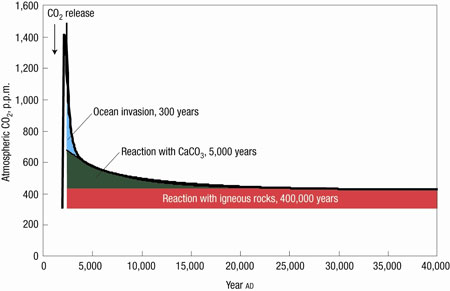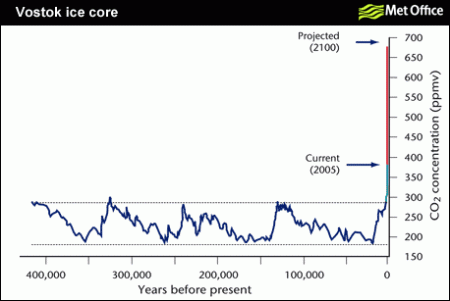Climatologist James Hansen emphatically argues that cumulative emissions are what really matter – how much warming the planet experiences depends on what proportion of the world’s fossil fuels get burned.
One reason for this is the long lifetime of CO2 in the atmosphere, with much of it remaining after thousands of years. That being said, the model simulation I have seen shows concentrations dropping sharply, and then tapering off with time:
It seems like it would be helpful to put together that chart with this one, showing historical and expected CO2 concentration increases:
A combined chart on the same scale would illustrate what would happen to CO2 concentrations if we stopped emitting at some point soon, specifically what the next few decades would look like.
It seems at least logically possible that timing of emissions could matter. Imagine, for instance, that having emissions cross a certain concentration threshold would really matter. If so, spreading out human emissions so that absorption of CO2 by the oceans would keep the concentration below that cap could be quite beneficial.
It seems an important question to sort out, given how the whole BuryCoal project is focused on limiting total human emissions, rather than trying to space them out.



Of course, since 99% of the greenhouse gas effect of CO2 takes place at concentrations below 300 ppm, by capturing infrared radiation at specific wavelengths, increasing CO2 concentration only means that the infrared is captured in a shorter distance. Higher concentrations have virtually no additional greenhouse gas effect, except, perhaps, in climate models that are tweaked to show that it does.
That’s not true. Doubling atmospheric CO2 concentrations increases global temperatures by about 3°C. We know that from the paleoclimatic record.
Mark – evidence in peer reviewed papers? Make sure you’ve checked the relevant Skeptical Science post.
BTW, why is the x-axis of the first graph labelled years AD?
Imagine, for instance, that having emissions cross a certain concentration threshold would really matter. If so, spreading out human emissions so that absorption of CO2 by the oceans would keep the concentration below that cap could be quite beneficial.
For instance, if some threshold level caused sufficient warming to initiate an unstoppable positive feedback?
Milan – you may find the following material on cumulative emissions that I put together a few months ago of interest. As ever, the issue is somewhat more complicated than one might first imagine. Regards Robin
Thanks for the link. How important do you think the timing of GHG emissions is, compared with their total historical quantity?
Perhaps I have misunderstood your question, but it seems to me that the phrase ‘timing of emissions’ is a part of the term of ‘total historical quantity’. This would further complicate any negotiations that nations might undertake to work out who was responsible for the situation we find ourselves in and who as a consequence, might agree to bear the brunt of any reductions.
I haven’t had a chance to check, but I imagine the IPCCC has carried out the maths to show what annual targets the World would have to agree upon to reduce the concentration of atmospheric CO2 emissions to say 350 ppm over whatever time scale was considered appropriate (100, 300, 500 years, etc.). I suppose it may be too late to negotiate a strategy going forward.
Drinking 50 beers in one night could kill you, whereas drinking one a day for 50 days will not. The question is whether there is any sense in which the climate is similar and there is some benefit from just stretching out the span over which a set amount of emissions occurs.
One major reason why it would be preferable to space out emissions is providing more time for adaptation in both human and natural systems. A species that might be driven to extinction by a 2°C temperature increase over 10 years might be able to survive an increase over 100 years. Similarly, it may be possible to replace human infrastructure at the end of its useful life, when climate change is happening slowly, but necessary to scrap it early if the rate of change is too rapid.
Of course, even if change is slow, there are limits to how much human and natural systems can adapt. Species that move northward and uphill in search of lower temperatures will eventually reach coastlines and mountaintops. Similarly, there is a limit to how much sea level rise can be managed with coastal defences.
It seems to me that everybody has already decided to ‘space out their emissions’ by simply not bothering to do much about them at all ! I also imagine most life on Earth will adapt and cope with changes to the climate, though just how comfortable or energy intensive life might turn out for our grand children and other generations remains to be seen.
And should an awareness dawn that perhaps it might be a good thing to start reducing emissions, we would still be left with the vexed issues of how negotiators would agree time scales and quotas for each country or grouping of nations. Historical cumulatives will have an important role to play in such an exercise, but might it be possible to incorporate some additional incentive that rewarded countries for agreeing to reduce their quotas faster than others?